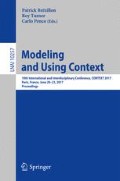Abstract
All of the semantic minimalists come together in seeking to reduce contextual inputs in semantics to a minimum, but they disagree over what this quantity may be, and more specifically, the extent to which something can still be classed as “minimal”. With this issue increasingly addressed, three versions of semantic minimalism can be identified: weak, strong, and radical. They are still gathered under the tag “Semantic Minimalism”, yet what they share is in fact less than their divergences as regards the minimal role of context. By revealing their divergent answers to the Range Problem and the Intention Problem, we will clearly see within semantic minimalism the schism, which is preliminary to assessing it.
Access this chapter
Tax calculation will be finalised at checkout
Purchases are for personal use only
Notes
- 1.
The distinction between weak minimalism and strong minimalism is borrowed from Robbins [17].
- 2.
Not precise enough as we see, “plus and minor a bit” blurs the scope of context-sensitive expressions, and in fact neither weak nor strong versions of semantic minimalism give a neat and definite scope.
- 3.
In this passage, Borg explains what the so-called formal route to semantics is: “According to minimalism, the only reasoning processes involved en route to recovery of semantic content are deductive, computationally tractable processes.” ([11], p. 114).
- 4.
This point benefits from an anonymous reviewer.
- 5.
These examples of hidden indexicals are tagged as “weather and other environmental reports (‘it is raining’)”, “terms with missing complements(‘John is ready’)”, “relational terms (‘Louis is a fan’)” and “perspectival terms (‘the hospital is on the left’)”.
- 6.
Prima facie, “liberal truth-conditions” seems to indicate that “John is ready” (relative to a context) alone cannot express a complete proposition since the complete proposition (truth-condition) is “John is ready for something in c” and it therefore seems that Borg stands in the same line with Bach in this regard. However, Borg construes a liberal truth-condition for the utterance of “John is ready” whereas Bach refutes that “John is ready” expresses any truth-evaluable proposition. As Bach ([7], p. 91) notes: “A great many sentences, such as ‘Jerry is ready’, ‘Tom is tall’, and ‘Leaves are edible’, do not express a proposition independently of context. It does not follow that such a sentence expresses a proposition relative to a context, for it may not express a proposition at all. Many supposed cases of context sensitivity are really instances of something else: semantic incompleteness.”
- 7.
This distinction is from the unpublished work “Reference, Intention, Context: Do Demonstratives Really Refer” of Bach.
- 8.
As Bach ([3], p. 435) claims, propositionalism is “the conservative dogma that every indexical-free declarative sentence expressed a proposition”.
- 9.
Borg’s analysis of Grice as a conventionalist is however debatable.
References
Bach, K.: Reference, Intention, and Context: Do Demonstratives Really Refer. Unpublished Work
Bach, K.: The semantics-pragmatics distinction: what it is and why it matters. In: Turner, K. (ed.) The Semantics/Pragmatics Interface from Different Points of View, pp. 65–84. Elsevier Science Ltd., Amsterdam (1999)
Bach, K.: The excluded middle: semantic minimalism without minimal propositions. Philos. Phenomenological Res. 73(2), 435–442 (2006)
Bach, K.: Minimalism for Dummies: Reply to Cappelen and Lepore. http://online.sfsu.edu/~kbach
Bach, K.: Why speaker intentions aren’t part of context (2009)
Bach, K.: Context dependance (such as it is). In: García-Carpintero, M., Kölbel, M. (eds.) The Continuum Companion to the Philosophy of Language, pp. 153–184. Continuum Press, London (2012)
Bach, K.: The lure of linguistification. In: Penco, C., Domaneschi, F. (eds.) What Is Said and What Is Not, pp. 87–97. CSLI Publications, Stanford (2013)
Borg, E.: Minimal Semantics. Oxford University Press, Oxford (2004)
Borg, E.: Intention-based semantics. In: Lepore, E., Smith, B.C. (eds.) The Oxford Handbook of Philosophy of Language, pp. 250–266. Clarendon Press, Oxford (2006)
Borg, E.: Minimalism versus contextualism in semantics. In: Preyer, G., Peter, G. (eds.) Context-Sensitivity and Semantic Minimalism: New Essays on Semantics and Pragmatics, pp. 339–359. Oxford University Press, Oxford (2007)
Borg, E.: Pursuing Meaning. Oxford University Press, Oxford (2012)
Cappelen, H.: Semantics and pragmatics: some central issues. In: Preyer, G., Peter, G. (eds.) Context-Sensitivity and Semantic Minimalism: New Essays on Semantics and Pragmatics, pp. 3–22. Oxford University Press, Oxford (2007)
Cappelen, H., Lepore, E.: A tall tale: in defense of semantic minimalism and speech act pluralism. Can. J. Philos. 34(Suppl.), 2–28 (2004)
Cappelen, H., Lepore, E.: Insensitive Semantics: A Defense of Semantic Minimalism and Speech Act Pluralism. Blackwell Publishing Ltd., Hoboken (2005)
Cappelen, H.: Reply to bach. In: PPR Symposium on Insensitive Semantics (2006)
Kaplan, D.: Demonstratives. In: Almog, J., Perry, J., Wettetein, H. (eds.) Themes from Kaplan, pp. 481–563. Oxford University Press, Oxford (1989)
Robbins, P.: Minimalism and modularity. In: Preyer, G., Peter, G. (eds.) Context-Sensitivity and Semantic Minimalism: New Essays on Semantics and Pragmatics, pp. 303–319. Oxford University Press, Oxford (2007)
Stokke, A.: Intention-sensitive semantics. Synthese 175(3), 383–404 (2010)
Acknowledgement
This paper is funded by Chinese Scholarship Council, grant number: 201306140060. Special thanks go to my supervisor Anne Reboul and the autonomous reviewer for helpful comments.
Author information
Authors and Affiliations
Corresponding author
Editor information
Editors and Affiliations
Rights and permissions
Copyright information
© 2017 Springer International Publishing AG
About this paper
Cite this paper
Hu, Y. (2017). Three Versions of Semantic Minimalism. In: Brézillon, P., Turner, R., Penco, C. (eds) Modeling and Using Context. CONTEXT 2017. Lecture Notes in Computer Science(), vol 10257. Springer, Cham. https://doi.org/10.1007/978-3-319-57837-8_23
Download citation
DOI: https://doi.org/10.1007/978-3-319-57837-8_23
Published:
Publisher Name: Springer, Cham
Print ISBN: 978-3-319-57836-1
Online ISBN: 978-3-319-57837-8
eBook Packages: Computer ScienceComputer Science (R0)

